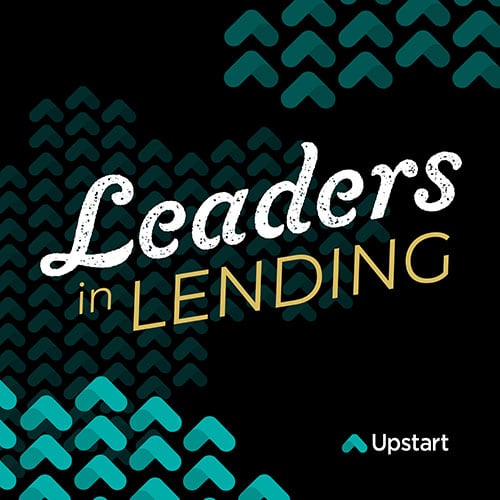Leaders in Lending | Ep. 45
From Cultural to Digital Transformation: Aligning Incentives and Exploring New Products
In this episode, Matt Deines, President & CEO at First Fed, shares how he vets potential fintech partnerships and how he ensures that the economics are aligned so that everyone can benefit.


GUEST SPEAKER
Matt Deines

ABOUT
First Fed
First Fed is a local community bank in Washington which has served customers and communities since 1923. Currently First Fed has 16 locations offering services in Clallam, Jefferson, King, Kitsap, and Whatcom counties. First Fed is a subsidiary of First Northwest Bancorp (FNWB), a holding company for the bank and other investments.
In 2020, First Fed donated over $1 million to non-profit organizations through our bank and foundation. Also, our team volunteered nearly 2,500 hours with non-profit organizations.
Key Topics Covered
- Why digital transformation starts with mindset
- First Fed’s fintech partnership journey
- How to align financial incentives in a bank-fintech partnership
- Ways to better target customers across the credit spectrum

“The reality is digital transformation really starts as a cultural transformation.”

“Partnerships between banks and fintechs are great symbiotic partnerships, as long as the economics are aligned properly.”

“It's not just zeros, ones, credit scores, and AI/ ML. It's also human beings on either side of the transaction."
EPISODE RECAP & SUMMARY
For a long time, banks didn't fully understand the value fintechs provide.
As partnerships with fintechs have grown, banks are experiencing that value firsthand, and they've also discovered an economic model that is a win-win for both.
In this episode, Matt Deines, President & CEO at First Fed, shares how he vets potential partners and how he ensures that the economics are aligned so that everyone can benefit.
We discuss:
- Why digital transformation starts with mindset
- First Fed’s fintech partnership journey
- How to align financial incentives in a bank-fintech partnership
- Ways to better target customers across the credit spectrum
Digital transformation
In banking, there’s no topic that comes up more often than digital transformation. But according to Matt, that focus is a bit misplaced.
Many financial institutions focus on the technology aspect. They go out and procure the best tech and the best UI. They want to install the greatest platforms and to offer the best technology experiences.
However, this line of thinking disregards the most important aspect of digital transformation — the primary goals of the customer.
That means shifting from a technology focus to, as Matt puts it, “providing better service, more value, and less brain damage for customers so that they will want to stay with us.”
In other words, it’s all about cultural transformation.
Human vs. technology
When should you deploy a technology solution versus a more human approach?
“It depends on what you’re dealing with, who you’re marketing to, and who your client base is or who you want them to be,” Matt says.
The truth is there are numerous technology solutions out there, but again, the primary goal of a bank should be making things easier and more convenient for both customers and employees.
How are you making the jobs of your employees easier so that they can spend more time on adding value to the customer experience?
That is a particularly important piece for community financial institutions. It’s the big reason many people return time after time; they appreciate that value-add whether it’s advice or simply a friendly smile.
Fintech partnerships
Matt took a different approach than many other banks when it comes to partnering with a fintech.
In 2018, he noticed that fintech valuations were at a much higher rate than banks. Because of this, he wanted First Fed to own part of a fintech relationship so that as valuations went up, they would have the rights to a portion of it.
So, in early 2021, First Fed formed a joint venture with Quin and entered into a partnership with a startup called Peace of Mind. The result was a product dubbed Lifestyle Protection, which provided financial wellness to individuals in need of financial advice and financial support.
What was the impetus of this approach?
According to Matt, community banks have always been great at one-to-one customer acquisition. Where they falter is in the one-to-many relationship.
Aligning incentives
While there are some fintechs that are getting bank charters, many don’t want to deal with the challenges of being regulated. For those fintechs, a partnership with a bank is a tempting avenue.
“As a bank, we have some really valuable things to bring to the table,” Matt says. “We understand compliance and risk management, we have capital, we have extremely low cost of funds for lending out, and we have abundant deposits to lend out.”
According to Deines, as long as the economics are aligned properly, these partnerships can be mutually beneficial.
“There are enough economics to go around,” he says, “and I think it’s in the best interests of the fintechs to make sure that their banks are being properly compensated for what they’re doing.”
Customers across the credit spectrum
These partnerships enable products that better target segments of the credit spectrum that are typically underserved by financial institutions.
Matt believes there are a few ways to go about doing that:
- Credit builder loans: If the secured loan is sold and managed responsibly, Matt believes it poses almost zero risk for the issuing institution and provides a really good solution for customers.
- Credit enhancement: Financial institutions could come in, almost like in insurance where you get reinsured, and take a significant amount of the credit yield and provide credit enhancement for that.
“In almost every circumstance, the banks, or the financial institutions, and the fintechs are working together,” Matt says, “and I think that’s where the most value gets created.”
There was a time when fintechs were seen by banks as the “barbarians at the gate,” according to Matt. Now, partnerships between banks and fintechs are presenting opportunities to provide the best solutions to customers.
Stay tuned for new episodes every week on the Leaders in Lending Podcast.





